BōnDry Hydration Pack Dryer
| Reviewer Information |
|---|
| Gender: | Male |
| Height: | 5' 6" (1.6 meters) |
| Weight: | 159 lb (72.1 kg) |
| Email: | mike-at-pahiker-dot-com |
| Home: | Southwest Pennsylvania, USA |
| Background: | I’ve been hiking since ’65 with occasional backpacking trips (backpacking became a love affair in the early 80’s). My first sleeping bag weighed in at 8 lb (3.6 kg) by itself! These days my loaded pack only weighs about 15 lb (6.8 kg) sans food. While most of my adventures are in the Northeast I’ve also been spending a good deal of time in the desert Southwest and most places in-between. My trips tend be in the cooler months - September through May - as I’m not much of a hot-weather person. |
Initial Report - Aug. 18, 2020
The BōnDry Hydration Pack Drier promises to dry a hydration pack automatically simply by inserting BōnDry into the pack and waiting for its capillary action to do its thing. By using BōnDry you reduce the chance of mold and mildew from growing in your hydration backpack. It works with hydration packs up to 2.5L (2.6 quarts), preferably in an area with less than 40% humidity, it will be interesting to test the BōnDry since my area rarely gets down to 40% humidity, tending to be in the 50-90% range.
| Product Information |
|---|
| Manufacturer: |
Fossil Outdoor, Inc.
www.fossiloutdoor.com |

|
| Size: |
3-7/16 x 17-3/16 in (8.7 x 43.7 cm) |
| Weight: |
1.24 oz (35.2 g) |
| Material: |
BōnDry is made from a combination of sustainably sourced plant fibers and recycled plastic bottles. |
MSRP: |
$19.99 US |
|
|
Initial Impressions
This should be an interesting and valuable product, if it does as promoted. Drying out my hydration packs have always been a real pain, especially since my insulated Camelbak has a hard ring opening which makes it difficult to get my hand into it, along with a drying cloth, to really clean out. To add insult to injury the Camelbak also has a divider inside that separates the bladder into left and right sides. Fossil Outdoor promises a solution to this as well, which will be covered when I get to the point of using it in my Camelbak.
Instructions
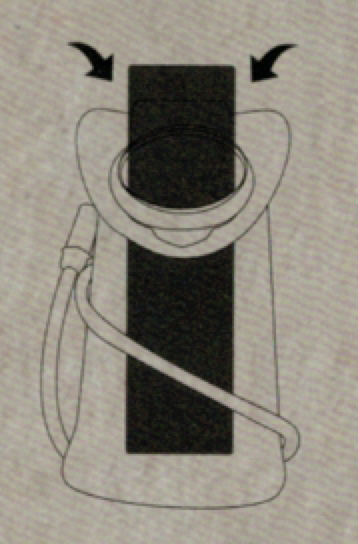
- Rinse the hydration bladder free of any non-water stuff that may be inside.
- Insert the BōnDry into the opening with the end hanging out. If the bladder is one of those from a brand that bisects their bladder, use scissors and cut the BōnDry between the two seams.
- The BōnDry goes right to work absorbing and transporting it all the way to the end to be evaporated, just leave it be until the next trip.
Two observations on the instructions: first, I will need to cut the BōnDry so that it fits into my bisected Camelbak; second, leaving it in until the next trip doesn’t work for me since I have several hydration packs, I select which one I will be using by the length of the trip and the weather I expect, so I will be interested in how long it actually takes to dry out the bladder.
First Use
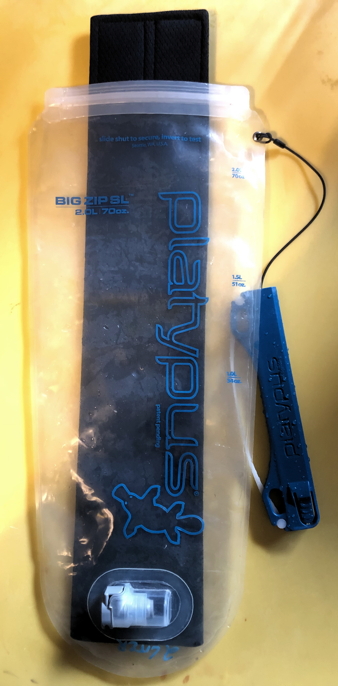
I always test something before I take it out into the Long-Term so I have some idea of just how it works. In this case the BōnDry doesn’t really go into the Long-Term as it is used to dry out the bladder after the trip, but I still wanted some idea of what to expect.
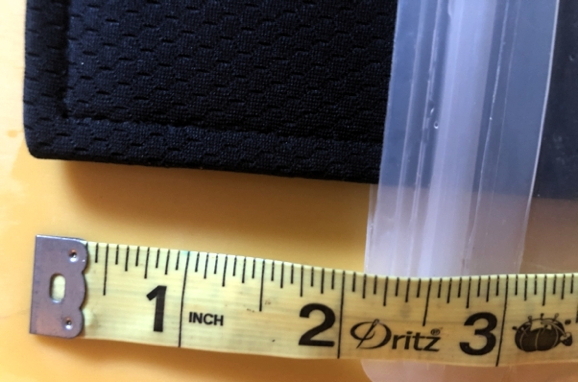
To test it I filled up my 2 L (2.1 qt) zip-top Platty then emptied it out. This bladder makes the test easy because it is clear (allowing me to see the water), and the zip-top provides a large opening to insert the BōnDry. In this bladder approximately 2.5 in (6.4 cm) sticks out of the top.
After inserting the BōnDry into the bladder I started a timer and began checking every hour. By the end of one hour the parts of the bladder in touch with the BōnDry were dry as a bone, but the surfaces not in contact were still wet. The same was true after 2 and 3 hours. At this point it was late and I decided just to leave it overnight and check it in the morning, 8 hours later and the entire bladder was bone dry.
Long-Term Report - Dec. 30, 2020
| Date |
Location |
Trail |
Distance Hiked |
Elevation Change |
Weather |
| Aug 20-22, 2020 |
Allegheny Natl. Forest, Pa. |
Kinzua/Marilla |
15.8 mi (25.4 km) |
812 ft (247.5 m) |
Sunny; 62-81F (17-27C) |
| Observations: |
These tests are not about the hike itself, but about drying out the bladder afterwards. When I got home I emptied out my Camelbak Hydration Pack, inserted the BōnDry sleeve, laid it down on a counter in my kitchen and started a timer. It took 2 days, 7 hours for it to dry, disappointing. My thoughts on this were that it was because when the Camelbak lies down it is not flat, the insulated part of the pack keeps it somewhat inflated, so the BōnDry does not come into contact with the water in the bladder. Even so I had hoped for a better dry time that this. |
|
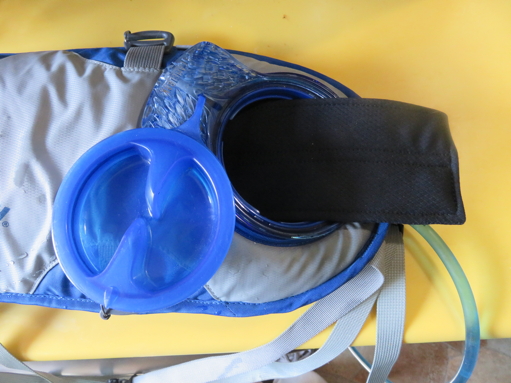 |
| Sept. 7, 2020 |
Laurel Hill State Park, Pa. |
Loop made of several trails in the park. |
8.8 mi (14 km) |
525 ft (160 m) |
Overcast; 49-74F (9-23C) |
| Observations: |
Upon arriving home I emptied my Camelbak, but this time I decided to hang it from a cabinet door, thinking the water would drain to the bottom where the BōnDry would be able to absorb it, it worked. This time the BōnDry managed to dry out the bladder in 7-8 hours, a much better drying time. The only remaining water was at the bottom of the bladder where the drinking tube connector sat, this is a hard spot to get to because of how the tube connects to the bladder, that part did dry out about 2 hours later after some re-cutting and repositioning the BōnDry sleeve. |
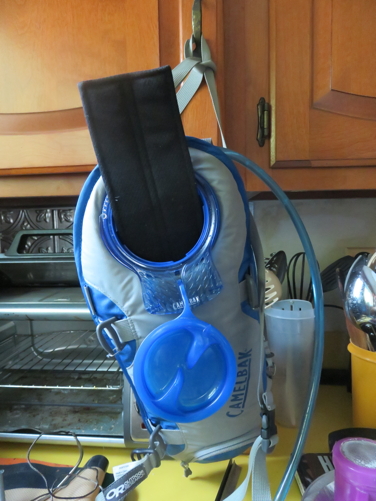 |
| Sept. 17, 2020 |
Little Buffalo State Park, Pa. |
Loop made of several trails in the park. |
7.1 mi (11.4 km) |
997 ft (304 m) |
Sunny; 68-75F (20-24C) |
| Observations: |
This was my second over-night trip (Kinzua being the first). This time I tried hanging the bag from a tree overnight (+8 hours). Last time I did not try an overnight (failing memory at 65). When I woke up the bladder was completely dry and ready for a new day of hiking.
This was a long drive home (3:14 plus 45 min stop for fuel and dinner), so I decided this time to hang the bladder from a hook in the back of my Jeep and see how things went. By the time I arrived at home the bladder was 90% dry (estimate) and only needed another hour to finish up.
I did make some changes from the last trip. I cut the BōnDry a little more so that I would not just reach the bottom of the Camelbak but actually lay a little in the bottom. I think this added to the quicker dry time because the BōnDry sits more in the bottom where the water drains to while hanging. |
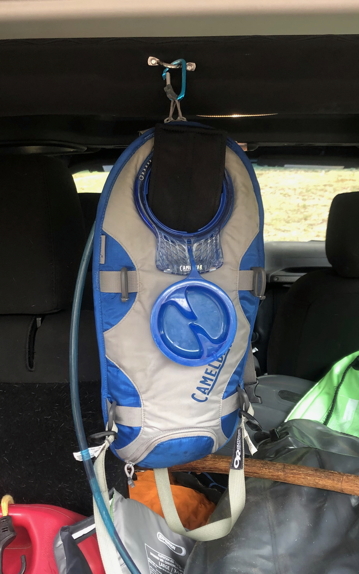 |
| Oct 8, 2020 |
Poe Paddy State Park, Pa |
Poe Paddy Tunnel Loop |
8.3 mi (13.4 km) |
997 ft (304 m) |
Partly Cloudy; 48-59F (8.9-15C) |
| Observations: |
Another long drive home (3:45 plus stops) so I again hung the bladder from my Jeep. It was a chilly evening trip home, with temps dropping into the low-40’s (4-5C) during the ride, so I had the heater on. This time the bladder was completely dry by the time I made it home. I don’t know if it was because of the little extra time from the last trip, or the heated Jeep, that allowed it to dry completely in 5 hours. Another possibility is that the BōnDry might perform better the more use it gets, hard to say, only conjectures at this point. |
There were several more hikes in Oklahoma and Arizona where temperatures ranged from the 20’s-F (below 0-C) to the 80’s F (mid-20’s to low 30’s-C), in the dry heat of Arizona to the dry cold of Oklahoma. In all cases I used the BōnDry after the hikes to dry out my CamelBak, tracking drying times and effectiveness.
While I do use bottles as well the openings on mine are too small (called a cola-style cap, not sure why, it’s bigger than a pop bottle) to allow for inserting the BōnDry without cutting it in half, or less, which would sacrifice its usefulness in the bladder.
Summary
The BōnDry performed remarkably well with the adjustments I made both to the BōnDry itself and to how I used it, I really like it - no more mold because of not being able to fully dry out the bladder with paper towels.
Typically during overnight trips I would empty out my bladder and let it dry overnight then start fresh the next morning. Since I hike in SW Pennsylvania there is never a shortage of water, even during moderate drought times. With the humidity in this area the bladder is always still a little wet in the morning, now it is bone-dry when I get up. I also found out that if I hang it in the back of my Jeep during the trip home, if it’s a 4-hour drive or longer, the bladder is dry when I get home and I can just toss it back in my gear cabinet. Yeah, this has really made life better, one of the most useful products I’ve come across.
Things I like:
- Easy to use, though difficult to insert into an insulated bladder with a split compartment.
- Easy to cut, and it does not split more on its own.
- Does speed up the drying process, I can put my bladder away as soon as I get home instead of waiting a day or two.
- No more paper towels or chamois cloths.
Things I don't like:
- With an insulated bladder it has to be hung to dry quickly, otherwise it’s a little better than stuffing it with paper towels.
- Hard to get into a split bladder, I have to shove my hand into the opening, along with the BōnDry, to get it down to the bottom. If it were stiffer it might go in on its own. I notice that as I use it the BōnDry becomes more flexible, so I imagine this will only get worse as time goes on.
- I would like to see one specifically made for water bottles, especially those with a narrow opening.
Acknowledgement
This ends my Long-Term Report, I’d like to thank BōnDry and BackpackGearTest.org for the opportunity to test the Hydration Pack Dryer.







